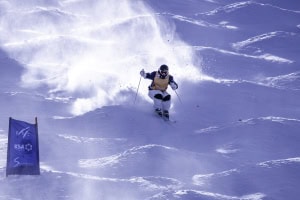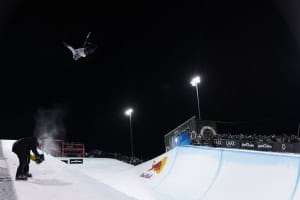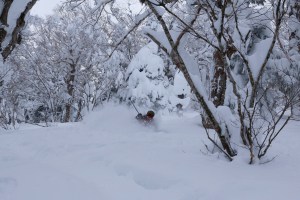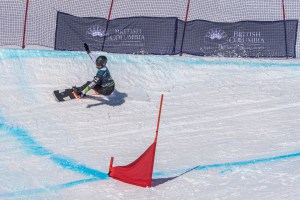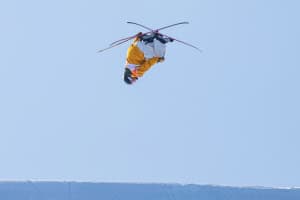Top 10 Moments from Australia’s Best Ever Winter Olympic Games

Image – Dan Himbrechts
The 2010 Vancouver Olympics are Australia’s best winter Games ever, with two golds and one silver medal. Apart from the medal winning performances, Australian athletes’ strong presence in almost all the events shows we’re a growing strength in winter sports.
Here, in no particular order, are Twenty Ten’s top 10 Aussie Olympic moments. This is a hard list to compile. As Victoria Deane, mother of skeleton athlete Anthony points out :
“Its those who have laboured and saved and struggled to ‘get’ to the Olympics who are my favourites. Some have done it with no external funding, no coaches, no sponsors, little support. So, to those who made it to the Olympics against all odds, your performances were my favourite moments.”
Top 10 Australian Olympic moments from Vancouver 2010:
Ramone, Jenny & Jono’s performances on very painful knee injuries
It’s one thing to give it your all at winter sport’s greatest competition, it’s quite another to grit your teeth and push through your limits whist carrying the kind of injury that would put most people on the couch. Ramone, with a serious knee injury only weeks old, Jenny -two weeks out of minor surgery and Jono, on his 11th knee reconstruction, all put pain aside to give incredible performances. While the agony showed on Jono’s face in the slow motion replays of his downhill run, Jenny could only hobble from the finish line of the ski cross and Ramone gave one tell tale wobble through the middle of his mogul ski, none let injury dictate their performance, each one gave it their all.

15 year old Brittney in the Olympic finish area
Teenagers Brittney and Scotty holding their own in fields where some of the athletes had been competing longer than they’ve been alive
15 year old Brittney Cox is less than half the age of a number of the girls she competed against in the moguls and Scotty James is the youngest kid to ever compete in the Olympic snowboard half pipe event. That makes them child prodigies and they produced performances that showed they more than deserved their places in the Olympic field. Scotty finished 21st in a 39 man field and Britt was 23rd out of 27. With such good introductions to Olympic competition, they’ll be old hands by the time they’re at the top of their game, who knows what kind of results they’ll be capable of then.
Video interviews with Britt and Scotty
Star on the ascent Dave Morris’s final jump in the qualifying round of the mens aerials
With a spot in the final round of the mens aerials competition on the line, Dave Morris knew he needed to produce something incredible. He’d never performed a full double-full full (a quad twisting triple back flip) at the elite level of competition before and had only ever done a handful on snow, but he took it to the sky straight as a pin and landed with confidence shown by his more seasoned competitors. Unfortunately he missed out on the finals by less than one whole point but with less than two years World Cup competition experience Dave Morris is only at the beginning of a stellar career.
More on Dave’s terrific jump
Self-funded Ben Mates half pipe moment

Ben Mates in the half pipe. Image – Dan Himbrechts
Bateman’s Bay local Ben Mates earned the 17th spot in an Olympic field of 39 with an outstanding semi final run and every point he won for his run of a frontside 900 15-feett above the lip, backside 540 into a humungous air to fakie melon landed switch, straight into a super slow huge cab 720 followed by an even bigger and slower frontside 720 was won double when you consider the amount commitment it took for him to get to the Games – a self funded athlete riding on nothing but his determination and awesome skill.
Ben finished up with a score of 27.5, 20.9 points behind winner Shaun White – one point for every million dollars of White’s $20 million net worth.
More on the mens half pipe event
Scott Kneller’s 7th place finish
In the lead up to the Games Scott Kneller broke his collar bone, putting his Olympic hopes in jeopardy. Then when the quota place list was released, Australia was not immediately allocated a male ski cross spot- another set back for the Jindabyne NSW local.
Just weeks later Scott more than proved he deserved the last minute reprieves received from medical clearance and second round quota allocation when he made it through to the small final of the Olympic ski cross and placed seventh overall in a demanding event.
This was an incredible result and one he fought for every step of the way, racing confidently and aggressively in difficult conditions.
More about Scott’s efforts
ToraMania
Australia’s sunshiny snowboarding superstar has been the darling of the snowboarding world for years, both for her incredible technical skills and her captivating persona. Now at last, having been denied one in 2006, she has the Olympic gold medal.
It was a hard fought competition and when Torah fell in her first finals run spectators both in the crowd and around the world gripped the edges of their seats – could she fight back and produce a winning show on her second attempt?

Image – Dan Himbrechts
Yes she could, with a run of stunning technical precision that wowed the judges over second place Kelly Clark’s (USA) huge airs.
Torah’s success will be a call to arms for girls (and boys) in Oz. As team mate and seventh place finisher Holly Crawford observed “every girl in Australia is going to want to buy a snowboard”. To be blunt, Torah is a marketing dream, the attractive, intelligent and morally correct (she is a practicing Morman) female in the uber-cool world of snowboarding makes her a perfect heroine for kids everywhere and with the gold around her neck she’s captivated Australia and the world, paving the way for a whole generation of little Torahs to begin planning how they’ll take on the world in snowboarding one day.
ToraMania
The Court of Arbitration for Sport ruling that Astrid and Cecilia would compete in the womens bobsleigh
When the Australian womens bobsleigh crew were left out of the Olympic field, they didn’t go cry in a corner. Instead Astrid Loch-Wilkinson and Cecilia McIntosh took up arms to fight for the place that, under the International Bobsleigh Federation’s (FBIT) rule regarding non-represented continents, should have been theirs.
Although the girls just missed out on making the cut based on their World Cup performances, the FBIT makes allowance for a team from a non represented continent (in this case Oceania) to be included in the Olympic field as long as they meet the minimum standards for Olympic competition.
By these rules, Australia should have automatically been given a place, but they weren’t and the FBIT argued that as Australia had a mens bobsleigh team, Oceania was represented.
But the Australian Olympic Committee appealed to the Court of Arbitration for Sport, which found in Australia’s favour. In a final happy ending, it was decided an extra position would be created, rather than kicking Ireland (the final qualified team) out of the field.
BK
Does more need to be said? By now the acronym has become part of the Australian vernacular. BK – short for Boxing Kangaroo of course – has been the mascot of Australian Olympic teams for years, but at this Games, for some reason, the right to display the BK was challenged when the Australian team hung an enormous flag from the balcony of their section of the Olympic Village. BK’s presence upset the IOC, but faced with an uproar that went far beyond the Australian team and involved both a huge cohort of athletes and the citizens of Vancouver – some of whom took to the street in protest – the IOC relented and BK stayed.
The drama became the press’s favourite story for several days and thrust BK into the spotlight. Aussie spectators carrying blow up Boxing Kangaroos or sporting BK paraphernalia were celebrities on the streets of Whistler and Vancouver. People wanted their photo taken with BK, they wanted to touch BK and many wanted go a couple of rounds in the ring with the boxing marsupial.

BK flies over the Vancouver Athletes’ Village
Jono Brauer’s Swansong and afterparty
As Australian alpine racer Jono Brauer made his way through the gates of a super G course for the last time, race announcer and skiing legend Chris Davenport could not praise him enough, back in Oz channel 9 announcer Steve Lee waxed lyrical about Jono’s astounding career. Considered one of the best in the world while still a teenager, Jono’s battled through 11 knee reconstructions in his career to keep living the alpine racing dream but this was to be his final race and he skied it superbly despite ongoing knee pain.
Jono Brauer with Steve Lee and team mate Craig Branch at his retirement party. Image – Jake McBride
Cheering him on were perhaps the most vocal set of set of Aussies alpine skiing has ever seen. The enthusiasm was carried through to Jono’s retirement party, held that night in Whistler, which was such a success certain TV announcers where a little under the weather the next morning while on Australian national television.
The spectator experience at Jono’s last race
Aussie Supporters
No crowd was louder, no fans more enthusiastic, no supporters more committed than the Australian contingent. Every friend and family member who travelled across the world to see their athlete compete in the race of their lives deserves accolades, but every Aussie supporter went further than just being there. Faces painted, flags draped about themselves like capes and blow up Boxing Kangaroos in their arms, the Aussie fans at every event were a spectacle in themselves. And sometimes they drew more attention than the athletes, with other spectators wanting their photos taken with the ‘crazy Aussies’ – a novelty from the land of sand and surf – and the BK.

Aussie supporters. Image – Dan Himbrechts


